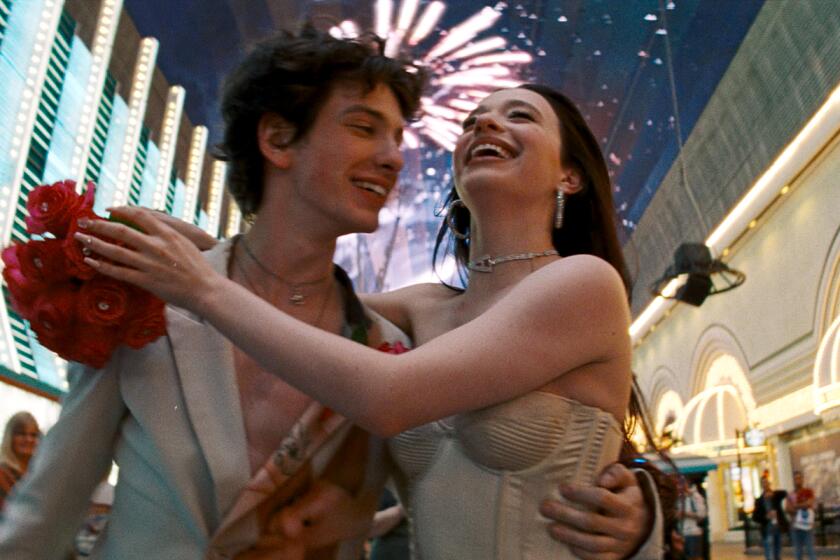Art review: ‘Leonardo da Vinci: Painter at the Court of Milan’
- Share via
From London — — In the second room of “Leonardo da Vinci: Painter at the Court of Milan,” a moving and unprecedented exhibition at the National Gallery, what some regard as the most beautiful portrait in the long history of European art draws a viewer in close. “Portrait of Cecilia Gallerani (The Lady With an Ermine)” shows the radiantly lovely, 16-year-old mistress of Ludovico Sforza, despotic ruler of Milan and the artist’s boss. She stares into an unseen distance while gently stroking the soft neck of an alert, snow-white ermine cradled in her arms.
Her torso twists in three-quarter view turned to her right, while her head is in three-quarter view turned to her left. It’s as if the young lady was passing by, heard something behind her and stopped to look. The static image rustles with implied motion, a flat image visually swollen with spatial volume.
Uncannily, the painting also reflects a viewer’s own encounter with it, unable to walk by without stopping to stare. You, art and the world converge.
Whether the gorgeous portrait merits the accolade as most beautiful ever is unprovable, yet the claim signals Leonardo’s extraordinary achievement. His artistic goal was a back-breaker — to make you fall in love with paint and wood, as surely as Sforza loved beautiful Cecilia. Rather than merely describe the complexity of human experience, this art physically embodies it. Therein lies Leonardo da Vinci’s aesthetic genius, as well as his stature as a watershed for Western art.
It doesn’t stop there either. The ermine symbolizes Sforza, whose membership in the aristocratic Order of the Ermine cements him to his plebeian beloved. Yet for all the graceful animal’s closely observed naturalism, this painted creature is a fiction — far larger than an ermine found in nature. No, Leonardo didn’t err. Art has its own demands, and the beast’s size fits his composition’s needs. The artist makes you believe in its truth.
Leonardo’s greatness lies in his capacity to create belief in the fiction you see. Endless nonsense gets written analyzing his various sitters’ psychology — think “Mona Lisa” — as if such a thing were possible. But really it’s belief and love that animate his art.
Or, to use different words with the same meanings, faith and charity do. Faith and charity are primary Christian virtues, a profound assertion of spiritual theology. Leonardo’s paintings reach for the ineffable, the sum of individual elements far exceeding the parts. The earthly balances on a knife-edge with the unearthly, creating sacred harmony.
Painter, engineer, geologist, musician, philosopher, equestrian, botanist, mathematician, inventor — Leonardo da Vinci (1452-1519) suffered a vexing problem, not uncommon for an ambitious polymath. Simply put: Distractions, distractions.
So prone to becoming absorbed in new challenges was he, and so determined to follow wherever his fascinated insights might lead, that in nearly half a century Leonardo began work on a total of only about 20 paintings. Picasso made that many in a month. And unlike the Renaissance Italian, the modern Spaniard almost always finished the ones that he started.
Today, only about 14 paintings entirely by Leonardo are known to exist. Four were never finished. Fate and the difficulty of attribution — the artist neither signed nor rigorously inventoried his work — mean the total number is slightly uncertain. They range from a diminutive portrait, barely 14 inches on a side, of the young Florentine Ginevra de’ Benci, to the famously ruined mural for a convent in Milan. In “The Last Supper,” Jesus has quietly announced that one disciple will betray him — an epic breach of faith and charity.
The rarity and fragility of Leonardo’s immensely influential paintings has led to an unusual result. Despite his authorship of the enigmatic “Mona Lisa,” arguably the most widely recognized painting in the world, his paintings have never before been the subject of a museum exhibition. Adjectives like “major” barely do justice to this astonishing show.
Luke Syson, curator at London’s National Gallery, spent five years assembling nine paintings — almost everything Leonardo produced in Milan — plus 54 related drawings and 13 more paintings and 12 drawings by seven students and associates. The curator’s readable catalog essay is a model of scholarship elegantly fused with engaging insight for a layman.
In addition to Cecilia’s portrait from Krakow, Poland, there’s the Louvre’s “La Belle Ferronnière” and “The Virgin of the Rocks”; “Portrait of a Musician” from Milan’s Biblioteca Ambrosiana; the Vatican’s unfinished “Saint Jerome”; “The Madonna Litta” from Russia’s Hermitage; and “Christ as Salvator Mundi,” a panel only recently — and quite convincingly — attributed to the artist. (“Ginevra de’ Benci,” painted in Florence, and the “Mona Lisa,” painted after he left Milan, are excluded.) The National Gallery’s own later version of “The Virgin of the Rocks” stands across the room from the Louvre’s altarpiece. A Scottish private collection lent “The Madonna of the Yarnwinder,” finished by another hand.
A full-scale copy of “The Last Supper” by his pupil Giampietrino (1500-50) hangs in a room upstairs. Filled with long-lost details from the prototype, it displays little of Leonardo’s painterly skill, but compensation comes from 17 drawings for the original.
The absence of prior museum presentations has contributed in turn to the corruption of Leonardo’s artistic reputation. The subtitle “Painter at the Court of Milan” is no accident: Syson means to rescue him from what might be called the Dan Brown Effect — the cheesy caricaturing of Leonardo’s wide-ranging interests, keen mind and serious ambitions. The show is not a fanciful tale of religious apostasy, fake secret societies or even hypothetical flying machines. Instead it’s the urbane — and more riveting — story of a supremely gifted artist coming to maturity.
Leonardo matters most as a painter. The show persuasively argues that his 1482 departure from the rich mercantile city of Florence, cradle of the Italian Renaissance, for the cruder, more bumptious northern city of Milan set the stage for his artistic blossoming. As court painter employed by the city’s ruler, he found security and freedom that allowed his talents to blossom.
The arrangement also represented mutual need. Sforza — called Il Moro (the Moor) because of his swarthy complexion — was but the regent for a hereditary duke as yet too young to govern. His grasp on power was tenuous. To boost his standing, Sforza took a cue from Florence’s all-powerful Medici family, deciding to re-create Milan as a cultural capital with himself as its leading patron.
Meanwhile, Leonardo, 30, needed work. Artists for hire in Florence functioned in a competitive milieu, unduly ruled by patrons’ whims. But in Milan he found a full-time employer for whom a court painter relocated from the shining city of Florence could add luster to the mantle of authority. For more than 16 years, the relationship between artist and patron flourished.
Leonardo was born outside the rural Tuscan hill town of Vinci on April 15, 1452, the illegitimate son of a peasant girl and a prosperous notary. A homosexual, he faced intransigent social hurdles. Apprenticed at 14 to the successful Florentine artist Andrea del Verrocchio, he had a leg up when he set out for Milan. But the lack of prospects earlier in life may finally have been a help if he was going to paint: Smart, but not born to privilege and schooling, he needed to look and to look hard.
Drawing, as the most direct record of artistic thought, was critical. The show’s drawings — studies for neck muscles, drapery folds, feet, various saints, the nervous system, buildings and more — are not merely ancillary. A sheet that records numerous studies for a dog’s paw shown frontally, in profile and in different angled views resonates with Cecilia and her ermine: You watch Leonardo slowly turning the paw around in his mind.
Also critical, he believed that the human soul resided in the head. Eyes connected the outside world to the spiritual mind, while bodily motions — properly understood — could reflect the mind’s movements.
That’s one reason the newly attributed “Christ as Salvator Mundi” looms large. Thought to have been painted for France’s King Louis XII after his troops drove Il Moro from Milan, Christ is shown holding a heavy, flawless sphere impossibly cut from rock crystal. An emblem of worldly perfection, the sphere’s clear quartz refracts light, delicately altering the hand’s perspective. The diffused blue color of the robe behind it repeats in the limpid orbs of his eyes, linking hand to divine vision.
Christ’s two eyes, anticipating Mona Lisa’s a few years on, are of two subtly different aspects. One looks straight at you, acknowledging your being. The other looks past you, taking in the cosmos.
In turn, you look straight at the painting — and past it too, taking in the “mundi” (the world) that Leonardo both encompassed and created. Material substance merges with immaterial spirit, forming a boundless reservoir of charity and faith.
The biggest entertainment stories
Get our big stories about Hollywood, film, television, music, arts, culture and more right in your inbox as soon as they publish.
You may occasionally receive promotional content from the Los Angeles Times.








